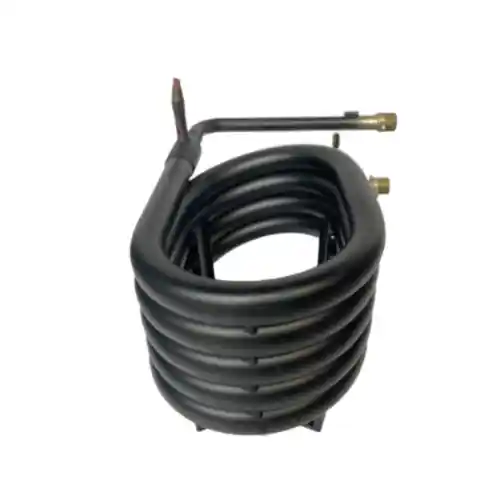1. Introduction
Polymer-coated tubes have revolutionized the field of coaxial heat exchangers by offering enhanced protection against corrosion, fouling, and other detrimental effects. In this article, we will explore the characteristics of polymer-coated tubes, their advantages, and their impact on the performance and efficiency of coaxial heat exchangers. We will delve into the composition of polymer coatings, their protective properties, and compare them with other tube materials commonly used in heat exchangers.
2. Composition and Structure of Polymer-Coated Tubes
Polymer-coated tubes consist of a base tube, typically made of materials such as copper, stainless steel, or aluminum, which is coated with a layer of polymer. The polymer coating acts as a protective barrier, shielding the base tube from corrosion, fouling, and other forms of damage. The following table provides an overview of the composition and structure of polymer-coated tubes:
| Tube Material | Polymer Coating |
|---|---|
| Copper, Stainless Steel, Aluminum | Polymer (e.g., epoxy, polyethylene, polyurethane) |
3. Advantages of Polymer-Coated Tubes in Coaxial Heat Exchangers
3.1 Enhanced Corrosion Resistance
Polymer coatings offer excellent corrosion resistance, protecting the base tube from corrosive substances present in the operating environment. The polymer layer acts as a barrier, preventing direct contact between the tube material and corrosive fluids. This enhanced corrosion resistance prolongs the service life of the heat exchanger and reduces maintenance requirements.
3.2 Reduced Fouling
Polymer coatings also exhibit anti-fouling properties, inhibiting the buildup of deposits on the tube surface. The smooth and non-adhesive nature of the polymer layer prevents the adhesion of contaminants, such as scale, algae, or sediment. This reduces the frequency of cleaning and enhances the heat transfer efficiency of the heat exchanger.
3.3 Improved Heat Transfer Efficiency
The presence of a polymer coating can improve the heat transfer efficiency of the coaxial heat exchanger. The smooth surface of the polymer layer promotes laminar flow and minimizes flow resistance, enabling optimal heat transfer between the fluid and the tube material. This results in improved system performance and energy efficiency.
3.4 Versatile Applications
Polymer-coated tubes find applications in a wide range of industries and processes. Their versatility allows for compatibility with various fluids, making them suitable for applications in HVAC systems, chemical processing, refrigeration, and more. The protective properties of the polymer coating ensure reliable and efficient heat transfer in diverse operating conditions.
4. Comparison with Other Tube Materials
4.1 Bare Tubes
Polymer-coated tubes offer significant advantages over bare tubes, particularly in terms of corrosion resistance and fouling prevention. The following table presents a comparison between bare tubes and polymer-coated tubes:
| Tube Material | Corrosion Resistance | Fouling Prevention |
|---|---|---|
| Bare Tubes | Moderate | Prone to fouling |
| Polymer-Coated Tubes | Excellent | Anti-fouling properties |
4.2 Other Protective Coatings
While there are other protective coatings available for heat exchanger tubes, polymer coatings stand out due to their versatility and cost-effectiveness. The following table compares polymer coatings with other commonly used protective coatings:
| Coating Type | Corrosion Resistance | Fouling Prevention | Heat Transfer Efficiency |
|---|---|---|---|
| Polymer | Excellent | Anti-fouling properties | Improved |
| Epoxy | Good | Moderate | Comparable |
| Ceramic | Excellent | Moderate | Comparable |
5. Applications of Polymer-Coated Tubes in Coaxial Heat Exchangers
Polymer-coated tubes are widely utilized in various industries for coaxial heat exchanger applications. Some notable applications include:
5.1 HVAC Systems
Polymer-coated tubes find extensive use in heating, ventilation, and air conditioning (HVAC) systems. Their corrosion resistance and anti-fouling properties ensure efficient heat transfer and reliable performance in HVAC coils and heat exchangers.
5.2 Chemical Processing
Polymer-coated tubes are well-suited for chemical processing applications, where they provide protection against corrosive chemicals and enable efficient heat transfer. They are used in heat exchangers for chemical reactors, distillation columns, and other chemical processes.
5.3 Refrigeration Systems
Coaxial heat exchangers incorporating polymer-coated tubes are commonly employed in refrigeration systems. The polymer coating protects the tubes from the corrosive effects of refrigerants, ensuring long-term reliability and optimal cooling performance.
6. Conclusion
Polymer-coated tubes offer significant advantages in coaxial heat exchangers, including enhanced corrosion resistance, reduced fouling, improved heat transfer efficiency, and versatile applications. The polymer coating acts as a protective barrier, safeguarding the base tube from corrosive substances and preventing the buildup of deposits. Compared to bare tubes and other protective coatings, polymer-coated tubes demonstrate superior performance in terms of corrosion resistance and fouling prevention. They find applications in HVAC systems, chemical processing, refrigeration, and various other industries. By incorporating polymer-coated tubes in coaxial heat exchangers, engineers can optimize system performance, increase durability, and reduce maintenance requirements.


